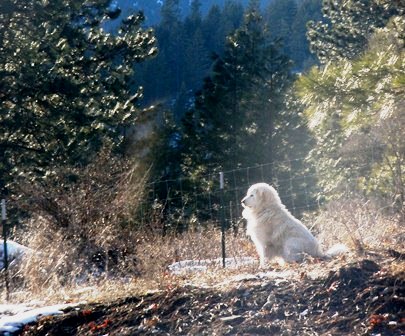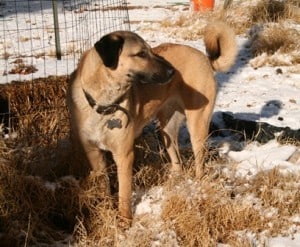So what is a livestock guardian dog? It is sometimes misunderstood among farmers and ranchers. Many people feel that all breeds of farm dogs are excellent guardians for their livestock.
Know that different types of dogs — herding dogs, companion dogs, and all-around farm dogs — are not always suited to be a livestock guardian dog.
However, there are several breeds categorized as livestock guardian dog breeds due to their deep instincts and drive to protect and defend their stock no matter what.

Livestock Guardian Dog
Here’s what makes a livestock guardian dog different from others:
- Spend their days and nights watching, roaming, and patrolling
- Deliberately mark the perimeter of their territory
- Bark warnings to potential intruders
- Large, strong, and powerful
- Willing to fight to the death if necessary to protect their charges
Livestock guardian dogs are typically gentle and peaceful unless provoked by intruders.
They systematically respond to potential threats and perceived danger, beginning with deterrents and attacking only as a last resort.
It’s important to know about them to be sure you buy one that meets your particular situation.
You will mostly want this if you get a livestock guardian dog.
What do livestock guard dogs do?
They seek to prevent the approach and entry of intruders with territorial marking. These dogs will deter approaching intruders with deep barking.
They will repeatedly run toward an approaching predator to frighten it off.
If the predator enters the dog’s territory and will not leave, the dog will attack and fight as hard as necessary.
All the livestock guard dog (LGD) breeds descend from dogs that have been working alongside shepherds and goat herders in Europe or Asia for centuries.
Each breed in the group can be traced back to a specific area of origin.
The dogs usually live calmly with their stock but will jump into action to keep their area safe and free of predators of all sizes, including bears, wolves and cougars.
Livestock guardian dog breeds instinctively act as defenders, but to work most effectively as a guardian, a puppy should be trained by another livestock guardian dog, a human prepared for the task, or preferably both.
Livestock guardian dogs are uniquely wired and must be treated and handled differently than pet dogs.
Different from herding dogs
While they can be trained to respond to commands, they will override them if they feel a need to protect or defend.
They also operate differently than livestock herding dogs. Herding dogs are motivated to move animals and keep them in formation.
The goal of a livestock guard dog is to keep its stock safe from harm.
When considering miniature cattle breeds, it’s important to also think about a getting a LGD.
A livestock guardian dog thrives on clear expectations and consistency, with proper introductions to new situations, visitors, livestock, and equipment entering the dog’s domain.
Livestock guard dogs know what is normal and typical on the farm and will be suspicious of anything unusual or out of place.
It’s important to train them
Ongoing, consistent training, reinforcement of boundaries, and reminders of expectations are vital for the success of the livestock guardian dog.
A human owner or handler should act as “alpha” and expect appropriate responses from the dog.
But at the same time it is important to respect the dog’s instincts, thinking process, and priority to defend above all else including obedience at times.
Your livestock guardian dog will bond to and protect people as well as livestock, so they can be used as personal and property guardians.
In some setups they can concurrently guard people and stock. Livestock guardian dogs can multi-task and are capable of instantly switching from gentle companion to strong defender.
They work around the clock, sleeping for short periods but all the while ready to protect, defend and fight.
LGD Livestock Guard Dog breeds
The appearance, personalities, and working styles of livestock guard dog breeds vary, and most people find some breeds more appropriate than others for a specific situation.
Most of the livestock guard dog breeds share these characteristics:
- Acute hearing, vision, sense of smell
- Physical strength and motivation to resist predators
- Independent mindset unlike that of other dogs, requiring training and supervision by an alpha human
- Calm, steady demeanor when all is well; relentless aggression toward intruding predator
- Wariness toward strangers until introduced by trusted human
- Gentleness with young stock and children
- Need for a job: something or someone to protect and socialize with
- Need for plenty of room and plenty of high quality food
Mature at 18 months to 3 years of age
Height/weight range from 25-34” at withers, 80-165#
Double coat, thick fur around neck
Tendency to expand territory if given opportunity
Differences between dog breeds lines include:
- Specific age of maturity
- Coat color, texture, and length
- Tendency to guard territory vs priority of guarding stock
- Tendency to wander vs. tendency to stay close to stock
- Will want to assist with sheep and goat births vs. tendency to stand back
Following are some brief descriptions of the livestock guard dog breeds most commonly found outside of Europe and Asia.

AKBASH
- From western Turkey
- Lean build
- Medium to long white coat
- Maturity: around three years
ANATOLIAN SHEPHERD
- From central Turkey
- Muscular neck/head, leaner body
- Short to medium length wiry coat
- Range of coat colors from white to black, solid to patterned, with or without mask
- Maturity: around three years
See Anatolian Dog

GREAT PYRENEES
- From southern France/northern Spain
- Lean build
- Long white coat, may have gray/rust/tan near face
- Maturity: around two years
See Great Pyrenees Club of America
KOMONDOR
- From Hungary
- Robust, strong build
- Long corded white coat at maturity
- Maturity: around three years
KUVASZ
- From Hungary
- Lean build
- Medium white coat, can be wavy
- Maturity: around two years

MAREMMA SHEEPDOG
- From Italy
- Muscular build
- Thick white or cream coat
- Maturity: around two years
See Maremmano
Several other livestock guardian dog breeds are becoming more available.
Some others are: Armenian Gampr, Central Asia Shepherd, Kangal, Polish Tatra, Sarplaninac, Russian Ovcharka, and Tibetan Mastiff.
Considering an livestock guardian dog?
When investigating livestock guardian dog breeds, we suggest evaluating all the different breeds available. Once you select a few breeds, look for breeds people respect and trust.
Initiate email or phone conversations to get a sense of the breeder’s values and standards and to learn if the breed is right for you.
Also ask about the specific characteristics of the breeder’s lines and if the dog will be suitable for your property, family, and priorities.
Make sure someone trained the dog and it wasn’t a show dog
One point to note: Some Livestock guardian dog breeds, including the Anatolian Shepherd, Great Pyrenees, and Komondor, have been recognized by the AKC as eligible for the show ring.
Many breeders begin to select for appearance and form rather than working capabilities.
Therefore, some dogs among the livestock guardian dog breeds have never worked. Their mothers weren’t able to train them to patrol boundaries and watch over livestock.
We recommend purchasing a Livestock guardian dog from a working farm rather than a show home.
Not only is it important to retain the work ethic and skills in the bloodlines, but the mother’s early training is extremely valuable for the later success of a livestock guardian dog.
Before we bought our Livestock guardian dogs, we spent about a year on this investigation process, evaluating every possibility, before narrowing it down to a breed and breeder.
Whether you live or work on a ranch or want to keep a livestock guardian dog to watch your animals at home, these dogs will work hard for you.
Learn what they need and how to care for them well. They will protect your livestock and provide you security.
Related Articles:
- Do You Need a Livestock Guardian Animal
- Suffolk Sheep ~ The Breed to Raise for Meat and Wool
- Fun Outdoor Activities To Do With Your Dog
- Best Organic Dog Food Comparison
- Quick Ways to Keep Your Dog Healthy and Fit
- 5 Best Personal Protection Dog Breeds
- Homemade Dog Food | How to Make Dog Food

Great summary of the LGD breeds. My family and I visited Polyface Farms in the spring. I’m posting a link to my site that has a picture of Michael, the Salatin’s LGD. As you can see, he’s quite the friendly fellow! I’m really enjoying your website!
Welcome, Stacey! What a treat it must have been to visit Polyface! Michael is quite a guy–3 great LGD breeds in one. Cuddly with kids, fierce with unwelcome critters. Thanks for sharing :)